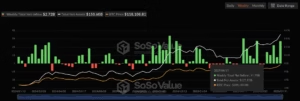The Pi Coin price experienced a significant drop on Tuesday, indicating that its recent upward momentum has paused. As investors began to take profits, the Pi Network (PI) token was trading at $1.1475, reflecting a sharp decline of 31% from its peak on Monday. This price adjustment has resulted in a market capitalization of $8 billion, positioning Pi Coin as the 19th largest cryptocurrency in the market.
Despite the recent dip, analysis using the Elliott Wave theory suggests a potential comeback for Pi Coin. This methodology identifies five stages that assets typically undergo during a bull market, marked by specific impulses and corrective phases. The recent rally of Pi Coin, which surged from a low of $0.5572 to a high of $1.6638—a remarkable increase of 200%—can be seen as the first phase of this Elliott Wave cycle.
Currently, the token appears to be in the second phase of the pattern, having pulled back and bottomed out at $0.9105. Should this pattern hold true, predictions indicate a potential rise to the 78.60% Fibonacci retracement level at approximately $2.455, signifying a projected increase of 116% from its current trading price.
Moreover, there are additional catalysts that might contribute to a bullish trajectory for the Pi Network. Recently, developers hinted at an important announcement set to occur during the forthcoming Consensus event in Toronto. One of the most anticipated developments could involve a listing on a major cryptocurrency exchange such as Binance, Coinbase, or HTX. Notably, HTX has engaged audiences with cryptic posts featuring the Pi logo, heightening the excitement around a possible partnership.
Another catalyst that could stimulate investor interest and potentially elevate the price of Pi Coin is an initiative aimed at encouraging developers to create applications on the Pi Network’s platform. In recent months, various established blockchains, such as Avalanche (AVAX) and Cronos (CRO), have taken similar strides and witnessed substantial growth as a result.
Lastly, the Pi Foundation’s approach towards easing concerns around token unlocks through a potential token burn could further invigorate market confidence. Holding billions of tokens, the foundation could implement strategic burns to manage supply and alleviate fears over inflationary pressures affecting token value.






